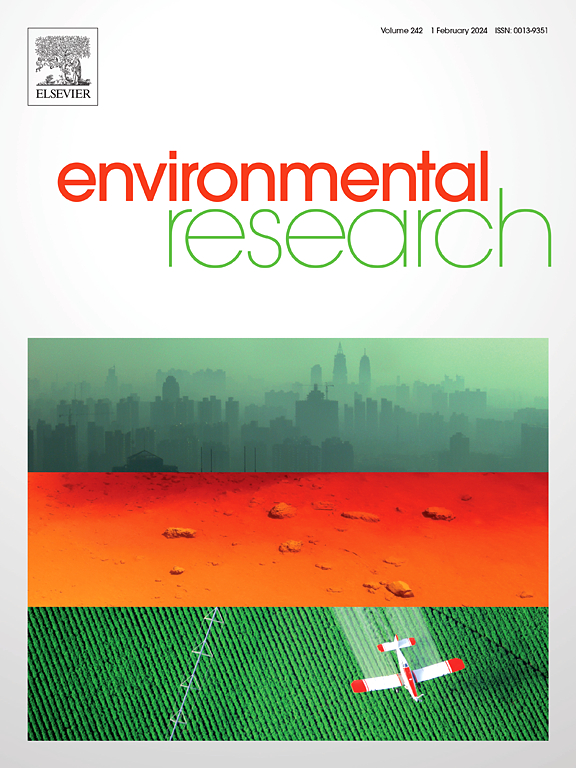氟虫胺类蚂蚁饵料中全氟辛烷磺酸的环境发生及其生态毒理学风险
IF 7.7
2区 环境科学与生态学
Q1 ENVIRONMENTAL SCIENCES
引用次数: 0
摘要
在实验室试验中,氟虫胺(n -乙基全氟辛烷磺酰胺;已证明,在有氧条件下,包括在巴西农业土壤中,EtFOSA可降解为全氟辛烷磺酸(PFOS)。因此,我们的目的是调查全氟辛烷磺酸在主要用于林业的农业地区的环境发生情况,这些地区主要使用以氟虫胺为基础的蚂蚁诱饵。采用超高效液相色谱-三重四极杆串联质谱联用技术,对选定的主要用于森林种植的微流域的地表水、地下水和沉积物样品进行了全氟辛烷磺酸及其前体物质的测定。全氟辛烷磺酸是最常检测到的化合物,存在于76%的地表水样品中,浓度高达50.6 ng L-1。也检测到EtFOSA和全氟辛烷磺酰胺(FOSA),但频率和浓度较低。在城市/工业和农业混合活动的流域中发现全氟辛烷磺酸浓度最高,表明存在多重污染源。然而,从松树和桉树人工林的监测井中采集的地下水样本也显示出可检测到的全氟辛烷磺酸污染,这可能是由于蚂蚁饵料应用引起的EtFOSA的生物降解。沉积物样本显示出季节变化,旱季的检出率较高,表明所研究的化合物具有高迁移率。采用风险商(RQ)方法进行的风险评估表明,所有测得的全氟辛烷磺酸浓度均超过欧盟内陆地表水年平均环境质量标准(AA-EQS),对水生生物群构成潜在风险。这项研究支持需要持续监测、制定法规和更安全的虫害防治替代方案,以减轻全氟辛烷磺酸污染及其环境风险。本文章由计算机程序翻译,如有差异,请以英文原文为准。
Environmental occurrence of perfluorooctanesulfonic acid from sulfluramid-based ant bait usage and its ecotoxicological risks
In laboratory trials, sulfluramid (N-ethyl perfluorooctane sulfonamide; EtFOSA) has been shown to degrade into perfluorooctanesulfonic acid (PFOS) under aerobic conditions, including in Brazilian agricultural soils. Thus, we aimed to investigate the environmental occurrence of PFOS in agricultural areas mostly used for forestry, where sulfluramid-based ant baits are primarily used. Surface water, groundwater, and sediment samples were collected from selected micro-watersheds, primarily used for forest plantation, and PFOS and its precursors were assessed by ultra-performance liquid chromatography coupled to a triple quadrupole mass spectrometer. PFOS was the most frequently detected compound, present in 76 % of surface water samples, with concentrations up to 50.6 ng L−1. EtFOSA and perfluorooctane sulfonamide (FOSA) were also detected, but at lower frequencies and concentrations. The highest PFOS concentrations were found in the watershed with mixed urban/industrial and agricultural activities, indicating multiple contamination sources. However, groundwater samples from monitoring wells inside planted forests of Pine and Eucalyptus also showed detectable PFOS contamination, likely due to the biodegradation of EtFOSA from ant bait applications. Sediment samples revealed seasonal variations, with higher detection rates during the dry season, suggesting a high-mobility of the studied compounds. Risk assessment using the risk quotient (RQ) approach indicated that all measured PFOS concentrations exceeded the European Union's annual average environmental quality standard (AA-EQS) for inland surface waters, posing potential risks to aquatic biota. This study endorses the need for ongoing monitoring, regulations, and safer pest control alternatives to mitigate PFOS contamination and its environmental risks.
求助全文
通过发布文献求助,成功后即可免费获取论文全文。
去求助
来源期刊

Environmental Research
环境科学-公共卫生、环境卫生与职业卫生
CiteScore
12.60
自引率
8.40%
发文量
2480
审稿时长
4.7 months
期刊介绍:
The Environmental Research journal presents a broad range of interdisciplinary research, focused on addressing worldwide environmental concerns and featuring innovative findings. Our publication strives to explore relevant anthropogenic issues across various environmental sectors, showcasing practical applications in real-life settings.
 求助内容:
求助内容: 应助结果提醒方式:
应助结果提醒方式:


